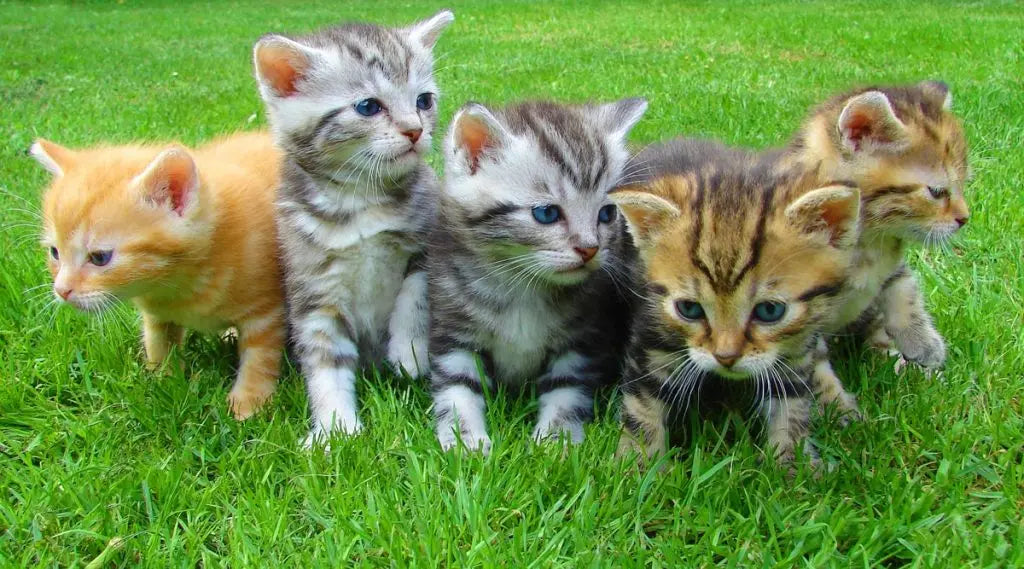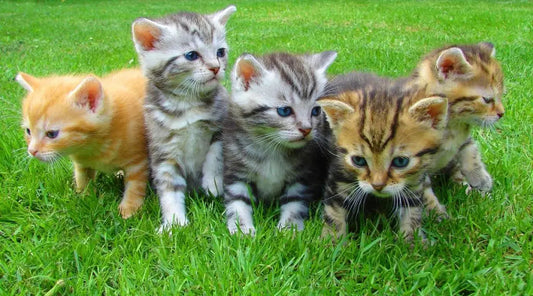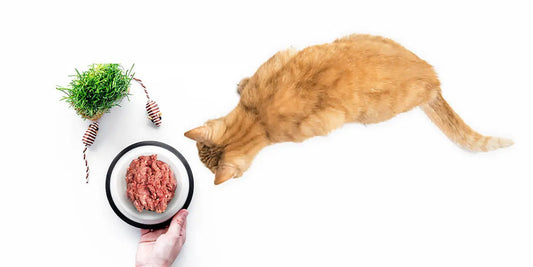
How Do Cats Communicate with Each Other? Understanding Cat Sounds
If you spend time around cats, you may get the impression that they speak their own secret language. Whereas dogs wear their hearts on their paws, cats remain more reserved, often preferring subtle signals to grand gestures. Yet they always seem in tune with one another.
If you’d like to form a more natural connection with your feline friend—and better meet their needs—it pays to learn their language.
So, how do cats communicate with each other? Through a combination of gestures, sounds, and scent. With a little practice, you too can interpret these signs and listen in on what they’re saying.
The Role of Vocalization in Cat Communication
Cats generally communicate their needs and wants by vocalizing. Careful listening is the best way to know when your cat is hungry, angry, or content.
These vocalizations come in many forms, with some reserved for other cats and others primarily meant for human ears.
Meowing: What It Means
When listening in on a cat conversation, what we think we hear is a quick back-and-forth made mainly of meows. This essential sound is what we, as people, hear most from our pets, so we often assume it’s the foundation of their language as a whole.
It turns out, however, that cats mostly reserve their meows for humans. They rarely meow at one another, but routinely do so when interacting with people.
“Meow” carries many meanings, including:
-
Greeting newcomers – Sometimes, a meow simply means, “Hello.” You’ve probably noticed a chorus of meows as you return home from work or enter a room.
-
Requesting attention – While cats protect their private lives, they also crave social interaction. If a cat feels isolated, they may meow to request playtime or petting.
-
Asking for food – Cats rely on you for food but can’t really ask for it in your language. So, when they feel peckish, you can expect them to meow until you serve dinner. Whether they prefer wet vs dry cat food, they’ll make sure to let you know when it’s mealtime.
-
Wanting to go outside – Most cats adore the outdoors and love acting on their natural instincts to patrol, hunt, and explore. When it's time for a backyard play session, they’ll likely meow by the door until you let them out (given they’re an outdoor cat).
Cats and humans have been partners for ages (10,000 years, by some estimates). During the course of our shared evolution, the meow emerged as cats’ primary means of communicating with us. When you hear “meow,” that’s your clue to assess what your cat wants from you.
Purring: A Sign of Contentment or Something Else?
When your cat lies cuddled on your lap, warm and well-fed, you’ll probably hear (and feel) a steady chorus of purring. But why do cats purr? It happens when cats exhale with their mouth closed, causing their vocal folds to vibrate at a rapid rate.
Generally, purring indicates satisfaction. When you hear it, it’s usually safe to assume all is right with your feline friend. It can, however, hold deeper meanings than mere contentment.
Purring can also signal:
-
Anxiety – Purring serves as a self-soothing mechanism, so cats may turn to it when they feel stressed. You may experience purring during vet visits or after a stressful encounter with another animal.
-
Greetings – Cats may also purr as a way of greeting friends and comforting their kittens. When you see it in feline social interactions, purring indicates a friendly, relaxed attitude.
-
Illness – Although less common, cats may also turn to purring’s self-soothing powers to calm their nervous system when sick or injured. If purring accompanies negative health symptoms, it’s best to investigate the cause.
To interpret purring, context is key. While it commonly signals ease, it can indicate other issues if accompanied by stressful markers or health red flags. Pay close attention to the surrounding scenario and your cat’s other behavior to decipher purring’s true meaning.
Hissing and Growling: Warning Signals
Chances are, your cat has had a run-in with a neighborhood dog or a fellow feline. In such encounters, your cat may unleash a flurry of growls and hisses.
No surprise here: hissing and growling signal aggression and serve as a warning to “back off.” Cats also hiss when afraid or stressed—feelings that typically occur during a threatening experience.
But beneath the surface, hissing and growling contain some nuances. If you closely observe your cat's behavior during hissing bouts, you’ll notice that it takes various forms, such as:
-
Quiet and open-mouthed – Often signifies general unease or displeasure.
-
Loud and accompanied by spitting – Indicates full-on aggression.
-
Casual, while playing – Often a signal to other cats to “stop.”
As with purring, correctly interpreting hissing and growling depends on accurately reading the context. While it’s nearly always a warning, the severity varies. It may indicate a violent encounter or merely serve as an expression of discomfort.
Chirping and Chattering: Understanding the Odd Sounds
By nature, cats yearn to hunt. It’s in their DNA, and even the most laidback house cats will snap to attention if they sense a rodent nearby.
It’s this inner drive to catch prey that draws cats to window ledges where they can spy on critters. If you stop to listen, you may notice:
-
Your feline chirping and chattering away, almost absentmindedly.
-
Their jaw bobbing up and down, as if they’re talking to themselves.
At first, this may look a bit bizarre. Turns out, this behavior’s roots run deep.
Feline chirps and chatter imitate the vocalizations made by furry prey animals like squirrels and chipmunks, and likely serve to lure unsuspecting critters into your cat’s paws. They may even chatter at you if you’re holding a tantalizing toy or treat.
Chattering also stems from the rush of adrenaline cats experience when faced with prey. In many ways, it's an instinctual response.
Sadly, angst may also incite chattering. It’s tough to watch a mouse running around through a window and be unable to pounce.
Yowling and Caterwauling: Communication Between Cats
Perhaps the most spine-chilling vocalizations on the list, caterwauling and yowling are piercing, painful sounds. Cats usually caterwaul repeatedly until the underlying cause dissipates.
When you hear yowling, it’s likely triggered by one of the following:
-
Distress or pain (most common)
-
Desire for attention
-
Going into heat (if young and female)
-
Territorial protection (especially if a new cat moves in or comes to visit)
If your cat begins to yowl, that’s your cue to take stock of the situation. Check them (if they allow you to approach) for signs of illness or injury. If you don’t detect anything, consider the surroundings for potential stressors.
If all appears to be in order, it may simply be a case of boredom or loneliness. Spend some quality time with your feline or consider fresh toys and exercise opportunities.
Non-Vocal Communication in Cats
Despite the variety of sounds they make, cats maintain their reputations as reserved creatures. Even if they maintain silence, however, they may still have plenty to say.
Cats possess an agile and acrobatic physique, and they use it to communicate alongside their vocalizations. They also occasionally employ scent marking to make their feelings known.
Learning to decode these non-vocal cues can unlock a wealth of information about your cat and their inner life.
Body Language as a Form of Communication
As with humans, subtle shifts of body weight or changes in posture can give away our moods and desires.
Observe your cat as they go about their business and monitor how they alter their body language in response to stimuli—it will likely fall into one of five categories:
-
Happy – Tail up, eyes half-shut, ears upright and facing forward.
-
Playful – Crouching, wiggling haunches, wagging tail, and wide-open eyes.
-
Anxious – Ears tilted back, tail drooping, slightly crouched, narrowed eyes.
-
Afraid – Wide eyes, tightly coiled tail, whiskers flat against cheeks.
-
Angry – Ears flat, back arched, swishing tail, arched back, fur standing on end.
Instead of guessing, tune into your cat’s instinctual expressions to better anticipate and meet their needs. This gives them the freedom to behave naturally.
As with other communication signals, always consider the context. A cat’s body language carries multiple meanings, depending on the scenario.
Scent Marking and Its Role in Territory Communication
At one point or another, you’ve probably noticed your cat headbutting your leg or rubbing against furniture and toys. This phenomenon is called “bunting” and cats employ it to leave behind pheromones that mark their territory. Beneath their fur, cats possess an array of sebaceous glands (those found in hair follicles) that release these pheromones upon contact.
Cats express their scent around their turf to:
-
Feel secure in their home base
-
Claim belongings or humans
-
Broadcast their presence
If your cat headbutts you, take it as a compliment—they clearly feel safe around you and want to mark you as part of their clan. Return the favor with a bit of affection.
Make Your Cat Feel Heard With Darwin’s
Felines may seem silent and reserved—especially in comparison to boisterous, barking dogs. But they effectively express their needs and feelings. With a little practice, you can easily read their cues and form a deeper bond.
At Darwin’s Natural Pet Products, we believe that thriving pets are those that live in line with their ancestral lineage—and that goes beyond communication. Cats evolved as predators, meant to dine on fresh cat food like raw meats. Keep their dinner in line with their DNA by choosing the expertly formulated nutrition of Darwin’s raw cat food.
Recreating your cat’s ancestral diet might feel daunting, but Darwin’s is here to guide you every step of the way. We invite you to schedule a free pet nutrition consultation with one of our expert menu consultants. Together, we’ll craft the perfect meal plan to help your pets flourish—plus, we can even bring it right to you with convenient pet food delivery. Get started today!
Sources:
- ASPCA. Meowing and Yowling. https://www.aspca.org/pet-care/cat-care/common-cat-behavior-issues/meowing-and-yowling
- Alley Cat Allies. The History of the Domestic Cat. https://www.alleycat.org/resources/the-natural-history-of-the-cat/
- PetMD. Why Do Cats Purr? 5 Meanings Behind a Purring Cat. https://www.petmd.com/cat/behavior/why-do-cats-purr
- Humane Society of the United States. Understanding feline language. https://www.humanesociety.org/resources/understanding-feline-language#:~:text=Growling%2C%20hissing%20or%20spitting%20indicates,they're%20making%20this%20noise.
- Daily Paws. Cat Chattering: Here's Why Your Cat Chirps at the Window. https://www.dailypaws.com/cats-kittens/behavior/common-cat-behaviors/cat-chattering
- PetMD. How To Read a Cat’s Body Language. https://www.petmd.com/cat/behavior/cat-body-language
- PetMD. Why Does My Cat Headbutt Me? https://www.petmd.com/cat/behavior/why-does-my-cat-headbutt-me


